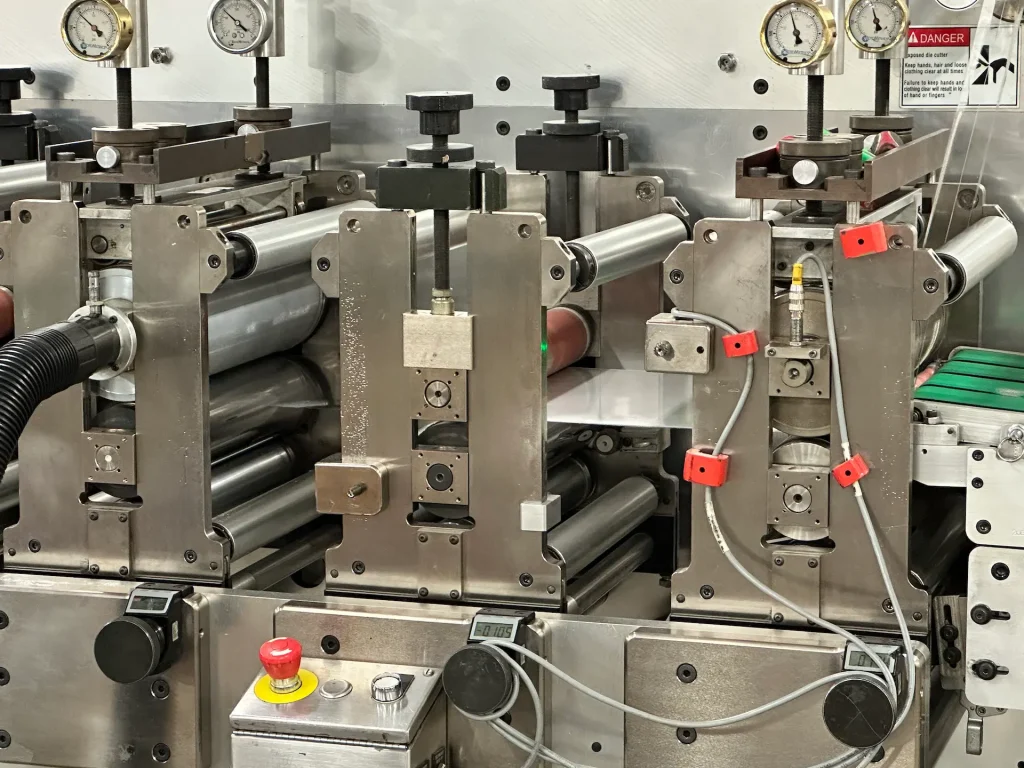
Since the 1940s, Colvin Friedman has been offering premium die-cutting and plastic die cutting services. We are experts in thermoplastics and synthetic polymers and can help you select the best material for your project. We commonly cut the following materials:
Polyethylene is a thermoplastic and is one of the most commonly produced plastics. It is non-toxic, appears semi-translucent, and can be produced in any almost opaque color desired. The die cutting process for Polyethylene varies based on its density. The most common varieties of Polyethylene include:
Low-Density Polyethylene
(LDPE)
High-Density Polythene
(HDPE)
Linear Low-Density Polyethylene (LLDPE)
Ultra-High Molecular Weight Polyethylene (UHMWPE)
LDPE is valued for its balance of flexibility and durability. It is often transparent and has a certain elastic quality.
HDPE is stronger, stiffer, and more resilient than LDPE. It is often opaque and has a higher melting point.
LLDPE occupies a middle ground between HDPE’s rigidness and LDPE’s flexibility, making it relatively versatile.
UHMWPE is prized for its extreme durability, low friction properties, and resistance to impact and wear.
Rotary Die Cutting
Flatbed Die Cutting
Rotary Die Cutting
Flatbed Die Cutting, more often requires Laser or Water Jet Cutting
Polypropylene is another thermoplastic polymer. While similar to Polyethylene, PP is more rigid, harder, and heat resistant. PP is also available in an array of colors. All varieties of Polypropylene can generally be cut using Flatbed Die Cutting. The most common varieties of Polypropylene include:
Homopolymer Polypropylene (PP-H)
Copolymer Polypropylene
(PP-C)
Random Copolymer
Polypropylene (PP-R)
PP-H is valued for its stiffness, tensile strength, and strong chemical and heat resistance.
PP-C’s chemical structure gives it higher impact resistance, especially at lower temperatures, reasonable durability, and slightly more flexibility than PP-H.
PP-R is notable for its improved clarity and flexibility, making it valued for transparent products and aesthetic purposes.
Rotary Die Cutting
Flatbed Die Cutting
Rotary Die Cutting
Polyvinyl Chloride is one of the most commonly produced plastics in the world. It is highly versatile and comes in both flexible and more rigid varieties. In its primary form it is white and brittle. More flexible varieties are better suited to Rotary Die Cutting, while all can be cut with flatbed die cutting. The most common varieties of Polypropylene include:
Unplasticized Polyvinyl
Chloride (uPVC)
Flexible Polyvinyl Chloride
(fPVC)
PVC Foam Board
(Expanded PVC)
uPVC is a stiffer variety of PVC. It is often used in many industries including construction and automotive.
fPVC is easier to cut than uPVC, due to the plasticizer integrated into it to make it more pliable and flexible.
Expanded PVC is turned into a foam via air expansion, and thus remains both rigid and lightweight.
Flatbed Die Cutting
Rotary or Flatbed Die Cutting
Flatbed Die Cutting
Polystyrene is a relatively inexpensive synthetic polymer. Different varieties have a wide variety of properties, ranging from being more solid or produced as foam.
Polystyrene is known for its general ease of processing. Flatbed die cutting can generally be used for the process, while Rotary Die cutting can be used for thinner sheets of material. The most common varieties of Polystyrene include:
General-Purpose Polystyrene (GPPS)
High-Impact Polystyrene
(HIPS)
Expanded Polystyrene
(EPS)
GPPS is commonly produced and generally more brittle. It has excellent clarity, rigidity, and dimensional stability.
HIPS is more impact resistant than other Polystyrene options, as it has been modified with rubber. It has less clarity, but is easier to cut.
EPS is a foam-like variety of Polystyrene. It is semi-rigid and has insulating properties.
Flatbed Die Cutting
Rotary or Flatbed Die
Cutting
Flatbed Die Cutting
Polyethylene Terephthalate is a common type of thermoplastic and is a member of the polyester family. It has a number of versatile forms, as well as applications across multiple industries.
Polyethylene Terephthalate in its primary state is generally colorless and can be cut with different techniques depending on thickness. The most common varieties of Polyethylene Terephthalate include:
Polyethylene Terephthalate
Glycol-Modified (PETG)
Amorphous PET (APET)
Crystalline PET (CPET)
PETG is a modified variety of PET that has greater flexibility, impact resistance and ease of processing, along with higher clarity and gloss. It is a common substitute for polyester.
APET possesses high clarity and gloss and is rigid with strong impact resistance. Additionally, it has strong heat resistance.
CPET is a very opaque variety of PET. Its melting point is even higher than APET’s, and is well suited for high heat environments.
Flatbed Die Cutting
Rotary or Flatbed
Die Cutting
Flatbed Die Cutting
All of the Above Plastic Materials are Recyclable.
If you would like more information about our custom metal die-cutting services, process, or product capabilities, please use the number below to call our Vice President, Josh Rodman. If you would like to receive a free project quote, click the button below.
Or call Josh at (707) 769-4488
Lorem Ipsum is simply dummy text of the printing and typesetting industry. Lorem Ipsum has been the industry’s standard dummy text ever since the 1500s,
1311 Commerce Street • Petaluma, CA 94954
copyright © 2025 Colvin Friedman Company. All Right Reserved.